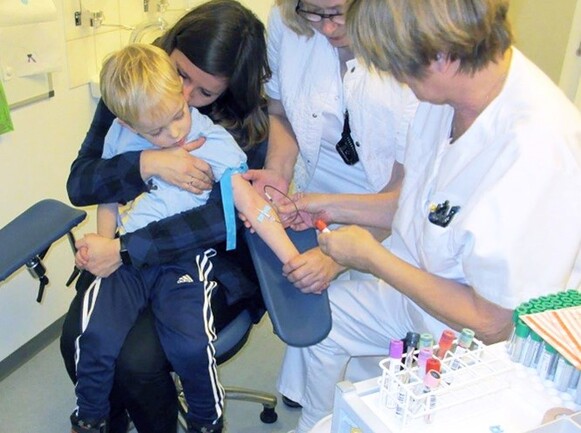Advice when taking your child for a blood test
Your child is due to have a blood test – what’s the best way you can help?
Here’s some advice for before, during and after the blood test. This advice can help you to reassure your child during the blood test.
-
Your child is due to have a blood test – what’s the best way you can help?
Here’s some advice for before, during and after the blood test. This advice can help you to reassure your child during the blood test.
-
1. Buy a soothing patch
You can prepare well in advance by buying soothing plasters at the pharmacy. 1 hour before the blood test, you put a patch in both elbows. Leave the patch on until it has worked and take it off 10 minutes before the sample is taken. If there is a slight pain when removing the patch, the child will not connect that pain directly to the blood test.
2. Explain
Spend time explaining to your child what’s about to happen. Tell your child that you and the person who will take the sample are there to help him/her.
3. Ask
Ask your child if he/she has any questions about the blood test. Ignorance or misunderstanding can make the experience worse for your child, so it’s important to try to find out what your child thinks about what’s going to happen.
4. Answer
Be honest. If your child asks if it hurts, tell him/her that it may be uncomfortable, but that we’ll do everything to help make sure it hardly hurts at all.
5. Be calm
Be calm and control any insecurity you may feel yourself. Your calmness will calm the child, so be aware of your body language and facial expression and stay calm during the blood test.
6. Inform
Please tell the staff about any previous experience with blood tests. We know the procedure – you know your child.
-
A small child can sit on your lap, or you can hold your child’s hand. Try to encourage your child to cooperate with the staff.
You can sit close together so the child can lean on you while interacting with the staff.

Be positive
Watch out for negative thoughts and speech and use positive expressions instead. For example, don’t say: “Don’t be afraid”. Instead, say: “You can do this!”.
Recognise
Recognise the way your child copes with the procedure. Some children will want to “watch”; others will not. Some like to blow soapy bubbles, sing or look at an iPad. Diversion often works well.
Be aware of your own reaction
It’s OK to feel sad about it but try to avoid showing this in connection with the blood test. Your child won’t see you as the ‘villain’ if you are actively involved and engaged.
Things that may help…
- Talking about something other than the procedure
- Humour
- Help to deal with the pain.
For example, say:
- “Let’s sing together”
- “Shall we go to the playground on the way home?”
- “What cake should I bake for your birthday?”
- “Take some deep breaths”.
Things that will not help
- Criticism
- Excuses
- Excessive empathy/compassion.
For example, don’t say:
- “Behave yourself!”
- “It’ll be over soon”
- “Mummy doesn’t like it either”
- “I’ll buy you a present if you sit still”
- “Don’t be scared”
-
Praise your child after the blood test. The staff might also reward the child with a little something.
Don’t allow the blood test to dominate your day and get back to your normal routine. However, the child might need to talk about the experience or draw a picture.
Stay positive and upbeat.
-
The doctor who ordered blood tests for your child will also give you the results.
-
If you have any questions, please do not hesitate to contact the phlebotomy staff.

